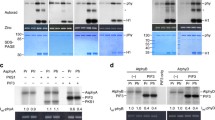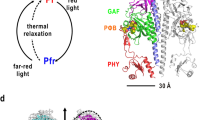Abstract
The kinetics of type 1 phytochrome were investigated in green, light-grown wheat. Phytochrome was measured by a quantitative sandwich enzyme-linked immunosorbent assay using monoclonal antibodies. The assay was capable of detecting down to 150 pg of phytochrome. In red light, rapid first-order destruction of the far-red-light-absorbing form of phytochrome (Pfr) with a half-life of 15 min was observed. Following white light terminated by red, phytochrome synthesis was delayed in darkness by about 15 h compared to plants given a terminal far-red treatment. Synthesis of the red-light-absorbing form of phytochrome (Pr) was zero-order in these experiments. Phytochrome synthesis in far-red light was approximately equal to synthesis in darkness in wheat although net destruction occurred in light-grown Avena sativa tissues in continuous far-red light, as has been reported for other monocotyledons. In wheat, destruction of Pfr apparently did not occur below a certain threshold level of Pfr or Pfr/total phytochrome. These results are consistent with an involvement of type 1 phytochrome in the photoperiodic control of flowering in wheat and other long-day plants.
Similar content being viewed by others
Abbreviations
- ELISA:
-
enzyme-linked immunosorbent assay
- FR:
-
far-red light
- HIR:
-
high-irradiance response
- Pfr:
-
farred-light-absorbing form of phytochrome
- Pr:
-
red-light-absorbing form of phytochrome
- Ptot:
-
total phytochrome (Pr + Pfr)
- R:
-
red light
References
Bradford, M.M. (1976) A rapid and sensitive method for the quantitation of microgram quantities of protein using the principal of protein-dye binding. Anal. Biochem. 72, 248–254
Butler, W.L., Lane, H.C., Seigelman, H.W. (1963) Nonphotochemical transformations of phytochrome in vivo. Plant Physiol. 38, 514–519
Carr-Smith, H.D., Johnson, C.B., Thomas, B. (1989) Action spectrum for the effect of day-extensions on flowering and apex elongation in green, light-grown wheat (Triticum aestivum L.). Planta 179, 428–432
Furuya, M. (1989) Molecular properties and biogenesis of phytochrome I and II. Adv. Biophys. 25, 133–167
Furuya, M., Ito, N., Tomizawa, K., Schäfer, E. (1991) A stable phytochrome regulates the expression of the phytochrome-1 gene in pea seedlings. Planta 183, 218–221
Galfre, G., Milstein, C. (1981) Preparation of monoclonal antibodies: Strategies and procedures. Methods Enzymol. 73, 3–46
Gammerman, A.Y., Fukshansky, L. (1974) A mathematical model of phytochrome — the receptor of photomorphogenetic processes in plants. Ontogenez 5, 122–129
Hartmann, K.M. (1966) A general hypothesis to interpret high energy phenomena of photomorphogenesis on the basis of phytochrome. Photochem. Photobiol. 5, 1172–1175
Hilton, J.R., Thomas, B. (1985) Comparison of seed and seedling phytochrome in Avena sativa L. using monoclonal antibodies. J. Exp. Bot. 36, 1937–1946
Hilton, J.R., Thomas, B. (1987) Photoregulation of phytochrome synthesis in germinating embryos of Avena sativa L. J. Exp. Bot. 38, 1704–1712
Jose, A.M., Vince-Prue, D., Hilton, J.R. (1977) Chlorophyll interference with phytochrome measurement. Planta 135, 119–123
Kilmartin, K.V., Wright, B., Milstein, C. (1982) Rat monoclonal antitubulin antibodies derived by using a new nonsecreting rat cell line. J. Cell Biol. 93, 576–582
Nagatani, A., Reed, J.W., Chory, J. (1993) Isolation and initial characterization of Arabidopsis mutants that are deficient in phytochrome A. Plant Physiol. 102, 269–271
Parks, B.M., Quail, P.H. (1993) Hy8, a new class of Arabidopsis long hypocotyl mutants deficient in functional phytochrome A. Plant Cell 5, 39–48
Principe, J.M., Hruschka, W.R., Thomas, B., Deitzer, G.F. (1992) Protein differences between two isogenic cultivars of barley (Hordeum vulgare L.) that differ in sensitivity to photoperiod and far-red light. Plant Physiol. 98, 1444–1450
Reed, J.W. Nagpal, P., Poole, D.S. FuruyaM.. Chory, J. (1993) Mutants in the gene for the red-far-red light receptor phytochrome B alter cell elongation and physiological responses throughout Arabidopsis development. Plant Cell 5, 147–157
Schäfer, E. (1975) A new approach to explain the ‘high irradiance responses’ of photomorphogenesis on the basis of phytochrome. J. Math. Biol. 2, 41–56
Schäfer, E., Marme, D., Marehal, B. (1972) In vivo measurements of the phytochrome photostationary state in far-red-light. Photochem. Photobiol. 15, 457–464
Sharrock, R.A., Quail, P.H. (1989) Novel phytochrome sequences in Arabidopsis thaliana: Structure, evolution, and differential expression of a plant regulatory photoreceptor family. Genes Devel. 3, 1745–1757
Shimazaki, Y., Cordonnier, M., Pratt, L.H. (1983) Phytochrome quantitation in crude extracts of Avena by enzyme-linked immunosorbent assay with monoclonal antibodies. Planta 159, 534–544
Shimazaki, Y., Pratt, L.H. (1985) Immunological detection with rabbit polyclonal and mouse monoclonal antibodies of different pools of phytochrome from etiolated and green Avena shoots. Planta 164, 333–344
Smith, H., Whitelam, G.C. (1990) Phytochrome, a family of photoreceptors with multiple physiological roles. Plant Cell Environ. 13, 695–707
Somers, D.E., Sharrock, R.A., Tepperman, J.M., Quail, P.H. (1991) The hy3 long hypocotyl mutant of Arabidopsis is deficient in phytochrome-b. Plant Cell 3, 1263–1274
Stewart, S.J., Pratt, L.H., Cordonnier-Pratt, M-M. (1992) Phytochrome levels in light-grown Avena change in response to end of day irradiations. Plant Physiol. 99, 1708–1710
Thomas, B. (1991) Phytochrome and photoperiodic induction. Physiol. Plant. 81, 570–577
Thomas, B., Lumsden, P.J. (1984) Photoreceptor action and photoperiodic induction in Pharbitis nil. In: Light and the flowering process, pp.107–121, Vince-Prue D., Cockshull K.E., Thomas B., eds. Academic Press
Thomas, B., Crook, N.E., Penn, S.E. (1984a) An enzyme-linked immunosorbent assay for phytochrome. Physiol. Plant. 60, 409–415
Thomas, B., Penn, S.E., Butcher, G.W., Galfre, G. (1984b) Discrimination between the red and far-red-absorbing forms of phytochrome from Avena sativa L. by monoclonal antibodies. Planta 160, 382–384
Tokuhisa, J.G., Daniels, S.M., Quail, P.H. (1985) Phytochrome in green tissue: Spectral and immunochemical evidence for two distinct molecular species of phytochrome in light-grown Avena sativa L. Planta 164, 321–332
Tokuhisa, J.G., Quail, P.H. (1983) Spectral and immunochemical characterisation of phytochrome isolated from light-grown Avena sativa (Abstr.) Plant Physiol. 72, Suppl., 85
Vierstra, R.D., Quail, P.H. (1983) Purification and initial characterisation of 124-kdalton phytochrome from Avena. Biochemistry 22, 2498–2505
Vince-Prue, D. (1975) Photoperiodism in Plants. McGraw-Hill, London
Wall, J.K., Johnson, C.B. (1983) An analysis of phytochrome action in ‘the high irradiance response’. Planta 159, 387–397
Wang, Y.C., Stewart, S.J, Cordonnier, M-M., Pratt, L.H. (1991) Avena sativa contains three phytochromes, only one of which is abundant in etiolated tissue. Planta 184, 96–104
Wang, Y.C., Stewart, S.J., Cordonnier, M-M., Pratt, L.H. (1993a) Temporal and light regulation of the expression of three phytochromes in germinating seeds and young seedlings of Avena sativa L. Planta 189, 384–390
Wang, Y.C., Stewart, S.J., Cordonnier, M-M, Pratt, L.H. (1993b) Spatial distribution of three phytochromes in dark- and lightgrown Avena sativa L. Planta 189, 391–396
Whitelam, G.C, Johnson, E., Peng, J.R., Carol, P., Anderson, M. L., Cowl, J.S. and Harberd, N.P. (1993) Phytochrome A null mutants of Arabidopsis display a wild-type phenotype in white-light. Plant Cell 5, 757–768
Author information
Authors and Affiliations
Additional information
The authors wish to thank Prof. Daphne Vince-Prue (University of Reading) for many helpful discussions regarding this work. Hugh Carr-Smith was supported by a Science and Engineering Research Council studentship and Chris Plumpton by an Agricultural and Food Research Council (AFRC) studentship. B. Thomas and G. Butcher were supported by the AFRC.
Rights and permissions
About this article
Cite this article
Carr-Smith, H.D., Johnson, C.B., Plumpton, C. et al. The kinetics of type 1 phytochrome in green, light-grown wheat (Triticum aestivum L.). Planta 194, 136–142 (1994). https://doi.org/10.1007/BF00201044
Received:
Accepted:
Issue Date:
DOI: https://doi.org/10.1007/BF00201044




